Overexpression and Activation of αvβ3 Integrin Differentially Affects TGFβ2 Signaling in Human Trabecular Meshwork Cells
Abstract
1. Introduction
2. Materials and Methods
2.1. Cell Culture
2.2. RNA Isolation
2.3. RNA-Seq Analysis
2.4. RT-qPCR Analysis
2.5. R Analysis
2.6. TGFβ2 ELISA Analysis
2.7. Bioannotations, Network and Pathway Analysis
3. Results
3.1. αvβ3 Integrin Alters the Expression Pattern of the TM Transcriptome
3.2. RNA-Seq Analysis Reveals Genes Enriched or Depleted by Activation of αvβ3 Integrin Signaling
3.3. Expression of Transcription Factors Is Differentially Regulated in CAβ3 and WTβ3cells
3.4. Hierarchical Clustering Reveals Differences in the Expression of ECM Protein Genes
3.5. Hierarchical Clustering Reveals Differences in the Expression of Genes Associated with Cell Adhesion
3.6. Hierarchical Clustering Reveals Differences in Genes Encoding Cytokines, Cytokine Regulators and Genes Involved in TGFβ, BMP and WNT Signaling
3.7. Hierarchical Clustering Reveals Differences in Genes Encoding GTP-Binding and Cytoskeleton-Associated Proteins
3.8. Hierarchical Clustering of Miscellaneous and Unclassified Genes
3.9. RT-qPCR Validation of Changes in Gene Expression
3.10. Panther Pathway Analysis Finds Gene Overrepresentation Only in CAβ3 Cells
3.11. PPI Network Analysis Shows Enrichment Only in CAβ3 Cells
4. Discussion
Supplementary Materials
Author Contributions
Funding
Institutional Review Board Statement
Informed Consent Statement
Data Availability Statement
Conflicts of Interest
References
- Kwon, Y.H.; Fingert, J.H.; Kuehn, M.H.; Alward, W.L.M. Primary Open-Angle Glaucoma. N. Engl. J. Med. 2009, 360, 1113–1124. [Google Scholar] [CrossRef]
- Braunger, B.M.; Fuchshofer, R.; Tamm, E.R. The aqueous humor outflow pathways in glaucoma: A unifying concept of disease mechanisms and causative treatment. Eur. J. Pharmaceut. Biopharmaceut. 2015, 95, 173–181. [Google Scholar] [CrossRef]
- Clark, A.F.; Wordinger, R.J. The role of steroids in outflow resistance. Exp. Eye Res. 2009, 88, 752–759. [Google Scholar] [CrossRef]
- Filla, M.S.; Faralli, J.A.; Desikan, H.; Peotter, J.L.; Wannow, A.C.; Peters, D.M. Activation of αvβ3 Integrin Alters Fibronectin Fibril Formation in Human Trabecular Meshwork Cells in a ROCK-Independent Manner. Invest. Ophthalmol Vis. Sci. 2019, 60, 3897–3913. [Google Scholar] [CrossRef] [PubMed]
- Roberts, A.L.; Mavlyutov, T.A.; Perlmutter, T.E.; Curry, S.M.; Harris, S.L.; Chauhan, A.K.; McDowell, C.M. Fibronectin extra domain A (FN-EDA) elevates intraocular pressure through Toll-like receptor 4 signaling. Sci. Rep. 2020, 10, 9815. [Google Scholar] [CrossRef] [PubMed]
- Faralli, J.A.; Filla, M.S.; McDowell, C.M.; Peters, D.M. Disruption of fibronectin fibrillogenesis affects intraocular pressure (IOP) in BALB/cJ mice. PLoS ONE 2020, 15, e0237932. [Google Scholar] [CrossRef] [PubMed]
- Filla, M.S.; Dimeo, K.D.; Tong, T.; Peters, D.M. Disruption of fibronectin matrix affects type IV collagen, fibrillin and laminin deposition into extracellular matrix of human trabecular meshwork (HTM) cells. Exp. Eye Res. 2017, 165, 7–19. [Google Scholar] [CrossRef] [PubMed]
- Filla, M.S.; Schwinn, M.K.; Nosie, A.K.; Clark, R.W.; Peters, D.M. Dexamethasone-associated cross-linked actin network (CLAN) formation in human trabecular meshwork (HTM) cells involves b3 integrin signaling. Invest. Ophthalmol. Vis. Sci. 2011, 52, 2952–2959. [Google Scholar] [CrossRef]
- Filla, M.S.; Schwinn, M.K.; Sheibani, N.; Kaufman, P.L.; Peters, D.M. Regulation of cross-linked actin network (CLAN) formation in human trabecular meshwork (HTM) cells by convergence of distinct b1 and b3 integrin pathways. Invest. Ophthalmol. Vis. Sci. 2009, 50, 5723–5731. [Google Scholar] [CrossRef]
- Filla, M.S.; Woods, A.; Kaufman, P.L. b1 and b3 integrins cooperate to induce syndecan-4 containing cross-linked actin networks (CLANs) in human trabecular meshwork (HTM) cells. Invest. Ophthalmol. Vis. Sci. 2006, 47, 1956–1967. [Google Scholar] [CrossRef]
- Faralli, J.A.; Filla, M.S.; Peters, D.M. Effect of αvβ3 Integrin Expression and Activity on Intraocular Pressure. Invest. Ophthalmol. Vis. Sci 2019, 60, 1776–1788. [Google Scholar] [CrossRef] [PubMed]
- Faralli, J.A.; Gagen, D.; Filla, M.S.; Crotti, T.N.; Peters, D.M. Dexamethasone increases αvβ3 integrin expression and affinity through a calcineurin/NFAT pathway. Biochim. Biophys Acta 2013, 1833, 3306–3313. [Google Scholar] [CrossRef] [PubMed]
- Tamm, E.R. Myocilin and glaucoma: Facts and ideas. Prog. Retin. Eye Res. 2002, 21, 395–428. [Google Scholar] [CrossRef]
- Hynes, R.O. Integrins: Bidirectional, Allosteric Signaling Machines. Cell 2002, 110, 673–687. [Google Scholar] [CrossRef]
- Harburger, D.S.; Calderwood, D.A. Integrin signaling at a glance. J. Cell Sci. 2009, 122, 159–163. [Google Scholar] [CrossRef]
- Martin-Bermudo, M.D.; Brown, N.H. Uncoupling integrin adhesion and signaling: The βPS cytoplasmic domain is sufficient to regulate gene expression in the Drosophila embryo. Genes Dev. 1999, 13, 729–739. [Google Scholar] [CrossRef]
- Carson, J.A.; Wei, L. Integrin signaling’s potential for mediating gene expression in hypertrophying skeletal muscle. J. Appl. Physiol. 2000, 88, 337–343. [Google Scholar] [CrossRef]
- Filla, M.S.; Lui, X.; Nguyen, T.D.; Polansky, J.R.; Brandt, B.R.; Kaufman, P.L.; Peters, D.M. In vitro localization of TIGR/MYOC in trabecular meshwork extracellular matrix and binding to fibronectin. IOVS 2002, 43, 151–161. [Google Scholar]
- Polansky, J.R.; Weinreb, R.; Alvarado, J.A. Studies on human trabecular cells propagated in vitro. Vis. Res. 1981, 21, 155–160. [Google Scholar] [CrossRef]
- Polansky, J.R.; Weinreb, R.N.; Baxter, J.D.; Alvarado, J. Human trabecular cells. I. Establishment in tissue culture and growth characteristics. IOVS 1979, 18, 1043–1049. [Google Scholar]
- Polansky, J.R.; Fauss, D.J.; Chen, P.; Chen, H.; Lütjen-Drecoll, E.; Johnson, D.; Kutz, R.M.; Ma, Z.D.; Bloom, E.; Nguyen, T.D. Cellular pharmacology and molecular biology of the trabecular meshwork inducible glucocorticoid response gene product. Ophthalmologica 1997, 211, 126–139. [Google Scholar] [CrossRef]
- Keller, K.E.; Bhattacharya, S.K.; Borrás, T.; Brunner, T.M.; Chansangpetch, S.; Clark, A.F.; Dismuke, W.M.; Du, Y.; Elliott, M.H.; Ethier, C.R.; et al. Consensus recommendations for trabecular meshwork cell isolation, characterization and culture. Exp. Eye Res. 2018, 171, 164–173. [Google Scholar] [CrossRef]
- Clark, R.; Nosie, A.; Walker, T.; Faralli, J.A.; Filla, M.S.; Barrett-Wilt, G.; Peters, D.M. Comparative genomic and proteomic analysis of cytoskeletal changes in dexamethasone-treated trabecular meshwork cells. Mol. Cell Proteom. 2013, 12, 194–206. [Google Scholar] [CrossRef] [PubMed]
- Kashiwagi, H.; Tomiyama, Y.; Tadokoro, S.; Honda, S.; Shiraga, M.; Mizutani, H.; Handa, M.; Kurata, Y.; Matsuzawa, Y.; Shattil, S.J. A mutation in the extracellular cysteine-rich repeat region of the b3 subunit activates integrins aIIbb3 and aVb3. Blood 1999, 93, 2559–2568. [Google Scholar] [CrossRef]
- Gagen, D.; Filla, M.S.; Clark, R.; Liton, P.; Peters, D.M. Activated avb3 integrin regulates avb5 integrin–mediated phagocytosis in trabecular meshwork cells. Invest. Ophthalmol. Vis. Sci. 2013, 54, 5000–5011. [Google Scholar] [CrossRef]
- Jiang, H.; Lei, R.; Ding, S.-W.; Zhu, S. Skewer: A fast and accurate adapter trimmer for next-generation sequencing paired-end reads. BMC Bioinform. 2014, 15, 182. [Google Scholar] [CrossRef]
- Dobin, A.; Davis, C.A.; Schlesinger, F.; Drenkow, J.; Zaleski, C.; Jha, S.; Batut, P.; Chaisson, M.; Gingeras, T.R. STAR: Ultrafast universal RNA-seq aligner. Bioinformatics 2012, 29, 15–21. [Google Scholar] [CrossRef] [PubMed]
- Robinson, M.D.; Oshlack, A. A scaling normalization method for differential expression analysis of RNA-seq data. Genome Biol. 2010, 11, R25. [Google Scholar] [CrossRef] [PubMed]
- Howe, K.L.; Achuthan, P.; Allen, J.; Allen, J.; Alvarez-Jarreta, J.; Amode, M.R.; Armean, I.M.; Azov, A.G.; Bennett, R.; Bhai, J.; et al. Ensembl 2021. Nucleic Acids Res. 2020, 49, D884–D891. [Google Scholar] [CrossRef]
- Szklarczyk, D.; Gable, A.L.; Lyon, D.; Junge, A.; Wyder, S.; Huerta-Cepas, J.; Simonovic, M.; Doncheva, N.T.; Morris, J.H.; Bork, P.; et al. STRING v11: Protein-protein association networks with increased coverage, supporting functional discovery in genome-wide experimental datasets. Nucleic Acids Res. 2019, 47, D607–D613. [Google Scholar] [CrossRef] [PubMed]
- Thomas, P.D.; Campbell, M.J.; Kejariwal, A.; Mi, H.; Karlak, B.; Daverman, R.; Diemer, K.; Muruganujan, A.; Narechania, A. PANTHER: A Library of Protein Families and Subfamilies Indexed by Function. Genome Res. 2003, 13, 2129–2141. [Google Scholar] [CrossRef] [PubMed]
- Kanehisa, M.; Goto, S. KEGG: Kyoto Encyclopedia of Genes and Genomes. Nucleic Acids Res. 2000, 28, 27–30. [Google Scholar] [CrossRef]
- Kanehisa, M. Toward understanding the origin and evolution of cellular organisms. Protein Sci. 2019, 28, 1947–1951. [Google Scholar] [CrossRef]
- Kanehisa, M.; Furumichi, M.; Sato, Y.; Ishiguro-Watanabe, M.; Tanabe, M. KEGG: Integrating viruses and cellular organisms. Nucleic Acids Res. 2020, 49, D545–D551. [Google Scholar] [CrossRef] [PubMed]
- Huang da, W.; Sherman, B.T.; Lempicki, R.A. Systematic and integrative analysis of large gene lists using DAVID bioinformatics resources. Nat. Protoc. 2009, 4, 44–57. [Google Scholar] [CrossRef] [PubMed]
- Huang da, W.; Sherman, B.T.; Lempicki, R.A. Bioinformatics enrichment tools: Paths toward the comprehensive functional analysis of large gene lists. Nucleic Acids Res. 2009, 37, 1–13. [Google Scholar] [CrossRef] [PubMed]
- Shao, X.; Taha, I.N.; Clauser, K.R.; Gao, Y.; Naba, A. MatrisomeDB: The ECM-protein knowledge database. Nucleic Acids Res. 2019, 48, D1136–D1144. [Google Scholar] [CrossRef]
- Consortium, T.U. UniProt: The universal protein knowledgebase in 2021. Nucleic Acids Res. 2020, 49, D480–D489. [Google Scholar] [CrossRef]
- Olender, T.; Safran, M.; Edgar, R.; Stelzer, G.; Nativ, N.; Rosen, N.; Shtrichman, R.; Mazor, Y.; West, M.D.; Keydar, I.; et al. An Overview of Synergistic Data Tools for Biological Scrutiny. Isr. J. Chem. 2013, 53, 185–198. [Google Scholar] [CrossRef]
- Zhao, Z.; Zhou, W.; Han, Y.; Peng, F.; Wang, R.; Yu, R.; Wang, C.; Liang, H.; Guo, Z.; Gu, Y. EMT-Regulome: A database for EMT-related regulatory interactions, motifs and network. Cell Death Dis. 2017, 8, e2872. [Google Scholar] [CrossRef]
- Filla, M.S.; Faralli, J.A.; Peotter, J.L.; Peters, D.M. The role of integrins in glaucoma. Exp. Eye Res. 2017, 158, 124–136. [Google Scholar] [CrossRef] [PubMed]
- Wang, D.-Z.; Chang, P.S.; Wang, Z.; Sutherland, L.; Richardson, J.A.; Small, E.; Krieg, P.A.; Olson, E.N. Activation of Cardiac Gene Expression by Myocardin, a Transcriptional Cofactor for Serum Response Factor. Cell 2001, 105, 851–862. [Google Scholar] [CrossRef]
- Tucker, T.; Tsukasaki, Y.; Sakai, T.; Mitsuhashi, S.; Komatsu, S.; Jeffers, A.; Idell, S.; Ikebe, M. Myocardin Is Involved in Mesothelial–Mesenchymal Transition of Human Pleural Mesothelial Cells. Am. J. Respir. Cell Mol. Biol. 2019, 61, 86–96. [Google Scholar] [CrossRef] [PubMed]
- Pei, X.H.; Lv, X.Q.; Li, H.X. Sox5 induces epithelial to mesenchymal transition by transactivation of Twist1. Biochem. Biophys. Res. Commun. 2014, 446, 322–327. [Google Scholar] [CrossRef]
- Benitah, S.A.; Valerón, P.F.; Rui, H.; Lacal, J.C. STAT5a activation mediates the epithelial to mesenchymal transition induced by oncogenic RhoA. Mol. Biol. Cell. 2003, 14, 40–53. [Google Scholar] [CrossRef] [PubMed]
- Zhang, K.; Myllymäki, S.M.; Gao, P.; Devarajan, R.; Kytölä, V.; Nykter, M.; Wei, G.H.; Manninen, A. Oncogenic K-Ras upregulates ITGA6 expression via FOSL1 to induce anoikis resistance and synergizes with αV-Class integrins to promote EMT. Oncogene 2017, 36, 5681–5694. [Google Scholar] [CrossRef] [PubMed]
- Fujimoto, S.; Hayashi, R.; Hara, S.; Sasamoto, Y.; Harrington, J.; Tsujikawa, M.; Nishida, K. KLF4 prevents epithelial to mesenchymal transition in human corneal epithelial cells via endogenous TGF-β2 suppression. Regen. Ther. 2019, 11, 249–257. [Google Scholar] [CrossRef]
- Bernier-Latmani, J.; Petrova, T.V. All TIEd up: Mechanisms of Schlemm’s canal maintenance. J. Clin. Investig. 2017, 127, 3594–3597. [Google Scholar] [CrossRef] [PubMed][Green Version]
- Villarreal, G., Jr.; Chatterjee, A.; Oh, S.S.; Oh, D.-J.; Rhee, D.J. Pharmacological Regulation of SPARC by Lovastatin in Human Trabecular Meshwork Cells. IOVS 2014, 55, 1657–1665. [Google Scholar] [CrossRef]
- Zhang, Y.; Cai, S.; Tseng, S.C.G.; Zhu, Y.-T. Isolation and Expansion of Multipotent Progenitors from Human Trabecular Meshwork. Sci. Rep. 2018, 8, 2814. [Google Scholar] [CrossRef]
- Boon, R.A.; Fledderus, J.O.; Volger, O.L.; van Wanrooij, E.J.; Pardali, E.; Weesie, F.; Kuiper, J.; Pannekoek, H.; ten Dijke, P.; Horrevoets, A.J. KLF2 suppresses TGF-beta signaling in endothelium through induction of Smad7 and inhibition of AP-1. Arter. Thromb Vasc Biol 2007, 27, 532–539. [Google Scholar] [CrossRef]
- SenBanerjee, S.; Lin, Z.; Atkins, G.B.; Greif, D.M.; Rao, R.M.; Kumar, A.; Feinberg, M.W.; Chen, Z.; Simon, D.I.; Luscinskas, F.W.; et al. KLF2 Is a novel transcriptional regulator of endothelial proinflammatory activation. J. Exp. Med. 2004, 199, 1305–1315. [Google Scholar] [CrossRef]
- Sowden, J.C. Molecular and developmental mechanisms of anterior segment dysgenesis. Eye 2007, 21, 1310–1318. [Google Scholar] [CrossRef] [PubMed]
- Liu, Y.; Allingham, R.R. Major review: Molecular genetics of primary open-angle glaucoma. Exp. Eye Res. 2017, 160, 62–84. [Google Scholar] [CrossRef]
- Zhao, Y.; Wang, S.; Sorenson, C.M.; Teixeira, L.; Dubielzig, R.R.; Peters, D.M.; Conway, S.J.; Jefcoate, C.R.; Sheibani, N. Cyp1b1 mediates periostin regulation of trabecular meshwork development by suppression of oxidative stress. Mol. Cell Biol 2013, 33, 4225–4240. [Google Scholar] [CrossRef]
- Allingham, R.R.; Liu, Y.; Rhee, D.J. The genetics of primary open-angle glaucoma: A review. Exp. Eye Res. 2009, 88, 837–844. [Google Scholar] [CrossRef]
- Khor, C.C.; Do, T.; Jia, H.; Nakano, M.; George, R.; Abu-Amero, K.; Duvesh, R.; Chen, L.J.; Li, Z.; Nongpiur, M.E.; et al. Genome-wide association study identifies five new susceptibility loci for primary angle closure glaucoma. Nat. Genet. 2016, 48, 556–562. [Google Scholar] [CrossRef]
- Cross, S.H.; Macalinao, D.G.; McKie, L.; Rose, L.; Kearney, A.L.; Rainger, J.; Thaung, C.; Keighren, M.; Jadeja, S.; West, K.; et al. A dominant-negative mutation of mouse Lmx1b causes glaucoma and is semi-lethal via LDB1-mediated dimerization. PLoS Genet. 2014, 10, e1004359. [Google Scholar] [CrossRef]
- Liu, P.; Johnson, R.L. Lmx1b is required for murine trabecular meshwork formation and for maintenance of corneal transparency. Dev. Dyn. 2010, 239, 2161–2171. [Google Scholar] [CrossRef] [PubMed]
- Danford, I.D.; Verkuil, L.D.; Choi, D.J.; Collins, D.W.; Gudiseva, H.V.; Uyhazi, K.E.; Lau, M.K.; Kanu, L.N.; Grant, G.R.; Chavali, V.R.M.; et al. Characterizing the “POAGome”: A bioinformatics-driven approach to primary open-angle glaucoma. Prog. Retin. Eye Res. 2017, 58, 89–114. [Google Scholar] [CrossRef] [PubMed]
- Fan, B.J.; Wang, D.Y.; Tham, C.C.Y.; Lam, D.S.C.; Pang, C.P. Gene Expression Profiles of Human Trabecular Meshwork Cells Induced by Triamcinolone and Dexamethasone. IOVS 2008, 49, 1886–1897. [Google Scholar] [CrossRef] [PubMed][Green Version]
- Liu, Y.; Gibson, J.; Wheeler, J.; Kwee, L.C.; Santiago-Turla, C.M.; Akafo, S.K.; Lichter, P.R.; Gaasterland, D.E.; Moroi, S.E.; Challa, P.; et al. GALC deletions increase the risk of primary open-angle glaucoma: The role of Mendelian variants in complex disease. PLoS ONE 2011, 6, e27134. [Google Scholar] [CrossRef] [PubMed]
- Kirwan, R.P.; Wordinger, R.J.; Clark, A.F.; O’Brien, C.J. Differential global and extra-cellular matrix focused gene expression patterns between normal and glaucomatous human lamina cribrosa cells. Mol. Vis. 2009, 15, 76–88. [Google Scholar]
- Webber, H.C.; Bermudez, J.Y.; Millar, J.C.; Mao, W.; Clark, A.F. The Role of Wnt/β-Catenin Signaling and K-Cadherin in the Regulation of Intraocular Pressure. IOVS 2018, 59, 1454–1466. [Google Scholar] [CrossRef]
- Zhang, Y.; Yang, Q.; Guo, F.; Chen, X.; Xie, L. Link between neurodegeneration and trabecular meshwork injury in glaucomatous patients. BMC Ophthalmol. 2017, 17, 223–229. [Google Scholar] [CrossRef] [PubMed]
- Liu, H.; Yang, Z.K.; Li, Y.; Zhang, W.J.; Wang, Y.T.; Duan, X.C. ABCB1 variants confer susceptibility to primary open-angle glaucoma and predict individual differences to latanoprost treatment. Biomed. Pharmacother. Biomed. Pharmacother. 2016, 80, 115–120. [Google Scholar] [CrossRef]
- Yang, X.; Luo, C.; Cai, J.; Powell, D.W.; Yu, D.; Kuehn, M.H.; Tezel, G. Neurodegenerative and Inflammatory Pathway Components Linked to TNF-α/TNFR1 Signaling in the Glaucomatous Human Retina. IOVS 2011, 52, 8442–8454. [Google Scholar] [CrossRef]
- King, R.; Li, Y.; Wang, J.; Struebing, F.L.; Geisert, E.E. Genomic Locus Modulating IOP in the BXD RI Mouse Strains. G3 Genes|Genomes|Genet. 2018, 8, 1571–1578. [Google Scholar] [CrossRef]
- Wordinger, R.J.; Fleenor, D.L.; Hellberg, P.E.; Pang, I.-H.; Tovar, T.O.; Zode, G.S.; Fuller, J.A.; Clark, A.F. Effects of TGF-b2, BMP-4, and gremlin in the trabecular meshwork: Implications for glaucoma. Invest. Ophthalmol. Vis. Sci. 2007, 48, 1191–1200. [Google Scholar] [CrossRef]
- Tovar-Vidales, T.; Fitzgerald, A.M.; Clark, A.F. Human trabecular meshwork cells express BMP antagonist mRNAs and proteins. Exp. Eye Res. 2016, 147, 156–160. [Google Scholar] [CrossRef]
- Pang, I.-H.; Millar, J.C.; Clark, A.F. Elevation of intraocular pressure in rodents using viral vectors targeting the trabecular meshwork. Exp. Eye Res. 2015, 141, 33–41. [Google Scholar] [CrossRef]
- Zode, G.S.; Sharma, A.B.; Lin, X.; Searby, C.C.; Bugge, K.; Kim, G.H.; Clark, A.F.; Sheffield, V.C. Ocular-specific ER stress reduction rescues glaucoma in murine glucocorticoid-induced glaucoma. J. Clin. Investig. 2014, 124, 1956–1965. [Google Scholar] [CrossRef]
- Yamaguchi, Y. Periostin in Skin Tissue Skin-Related Diseases. Allergol. Int. 2014, 63, 161–170. [Google Scholar] [CrossRef]
- Paylakhi, S.H.; Yazdani, S.; April, C.; Fan, J.-B.; Moazzeni, H.; Ronaghi, M.; Elahi, E. Non-housekeeping genes expressed in human trabecular meshwork cell cultures. Mol. Vis. 2012, 18, 241–254. [Google Scholar]
- Hopfer, U.; Fukai, N.; Hopfer, H.; Wolf, G.; Joyce, N.; Li, E.; Olsen, B.R. Targeted disruption of Col8a1 and Col8a2 genes in mice leads to anterior segment abnormalities in the eye. FASEB J. 2005, 19, 1232–1244. [Google Scholar] [CrossRef]
- Takahashi, E.; Inoue, T.; Fujimoto, T.; Kojima, S.; Tanihara, H. Epithelial mesenchymal transition-like phenomenon in trabecular meshwork cells. Exp. Eye Res. 2014, 118, 72–79. [Google Scholar] [CrossRef]
- Bermudez, J.Y.; Webber, H.C.; Brown, B.; Braun, T.A.; Clark, A.F.; Mao, W. A Comparison of Gene Expression Profiles between Glucocorticoid Responder and Non-Responder Bovine Trabecular Meshwork Cells Using RNA Sequencing. PLoS ONE 2017, 12, e0169671. [Google Scholar] [CrossRef] [PubMed]
- Zhang, R.; Wu, Y.; Xie, F.; Zhong, Y.; Wang, Y.; Xu, M.; Feng, J.; Charish, J.; Monnier, P.P.; Qin, X. RGMa mediates reactive astrogliosis and glial scar formationthrough TGFβ1/Smad2/3 signaling after stroke. Cell Death Differ. 2018, 25, 1503–1516. [Google Scholar] [CrossRef] [PubMed]
- Schnichels, S.; Conrad, S.; Warstat, K.; Henke-Fahle, S.; Skutella, T.; Schraermeyer, U.; Julien, S. Gene expression of the repulsive guidance molecules/neogenin in the developing and mature mouse visual system: C57BL/6J vs. the glaucoma model DBA/2J. Gene Expr. Patterns 2007, 8, 1–11. [Google Scholar] [CrossRef] [PubMed]
- Liton, P.B.; Luna, C.; Challa, P.; Epstein, D.L.; Gonzalez, P. Genome-wide expression profile of human trabecular meshwork cultured cells, nonglaucomatous and primary open angle glaucoma tissue. Mol. Vis. 2006, 12, 774–790. [Google Scholar]
- Liu, Y.; Allingham, R.R.; Qin, X.; Layfield, D.; Dellinger, A.E.; Gibson, J.; Wheeler, J.; Ashley-Koch, A.E.; Stamer, W.D.; Hauser, M.A. Gene Expression Profile in Human Trabecular Meshwork From Patients With Primary Open-Angle Glaucoma. IOVS 2013, 54, 6382–6389. [Google Scholar] [CrossRef]
- Thomson, B.R.; Souma, T.; Tompson, S.W.; Onay, T.; Kizhatil, K.; Siggs, O.M.; Feng, L.; Whisenhunt, K.N.; Yanovitch, T.L.; Kalaydjieva, L.; et al. Angiopoietin-1 is required for Schlemm’s canal development in mice and humans. J. Clin. Investig. 2017, 127, 4421–4436. [Google Scholar] [CrossRef]
- Schueler, M.; Braun, D.A.; Chandrasekar, G.; Gee, H.Y.; Klasson, T.D.; Halbritter, J.; Bieder, A.; Porath, J.D.; Airik, R.; Zhou, W.; et al. DCDC2 Mutations Cause a Renal-Hepatic Ciliopathy by Disrupting Wnt Signaling. Am. J. Hum. Genet. 2015, 96, 81–92. [Google Scholar] [CrossRef]
- Itakura, T.; Peters, D.M.; Fini, M.E. Glaucomatous MYOC mutations activate the IL-1/NF-κB inflammatory stress response and the glaucoma marker SELE in trabecular meshwork cells. Mol. Vis. 2015, 21, 1071–1084. [Google Scholar]
- Huveneers, S.; Danen, E.H.J. Adhesion signaling—Crosstalk between integrins, Src and Rho. J. Cell Sci 2009, 122, 1059–1069. [Google Scholar] [CrossRef]
- Rao, P.V.; Pattabiraman, P.P.; Kopczynski, C. Role of the Rho GTPase/Rho kinase signaling pathway in pathogenesis and treatment of glaucoma: Bench to bedside research. Exp. Eye Res. 2017, 158, 23–32. [Google Scholar] [CrossRef] [PubMed]
- Paylakhi, S.H.; Fan, J.B.; Mehrabian, M.; Sadeghizadeh, M.; Yazdani, S.; Katanforoush, A.; Kanavi, M.R.; Ronaghi, M.; Elahi, E. Effect of PITX2 knockdown on transcriptome of primary human trabecular meshwork cell cultures. Mol. Vis. 2011, 17, 1209–1221. [Google Scholar] [PubMed]
- Maddala, R.; Rao, P.V. Global phosphotyrosinylated protein profile of cell-matrix adhesion complexes of trabecular meshwork cells. Am. J. Physiol. Cell Physiol. 2020, 319, C288–C299. [Google Scholar] [CrossRef] [PubMed]
- Lukas, T.J.; Du, P.; Miao, H.; Lin, S. Differential effects of elevated hydrostatic pressure on gene expression and protein phosphorylation in optic nerve head astrocytes. In The Mystery of Glaucoma; Tomas Kubena; IntechOpen Ltd.: London UK, 2011. [Google Scholar] [CrossRef]
- Sundberg-Smith, L.J.; DiMichele, L.A.; Sayers, R.L.; Mack, C.P.; Taylor, J.M. The LIM Protein Leupaxin Is Enriched in Smooth Muscle and Functions As an Serum Response Factor Cofactor to Induce Smooth Muscle Cell Gene Transcription. Circ. Res. 2008, 102, 1502–1511. [Google Scholar] [CrossRef]
- Pattabiraman, P.P.; Rao, P.V. Hic-5 Regulates Actin Cytoskeletal Reorganization and Expression of Fibrogenic Markers and Myocilin in Trabecular Meshwork Cells. IOVS 2015, 56, 5656–5669. [Google Scholar] [CrossRef] [PubMed]
- Navarro-Corcuera, A.; López-Zabalza, M.J.; Martínez-Irujo, J.J.; Álvarez-Sola, G.; Ávila, M.A.; Iraburu, M.J.; Ansorena, E.; Montiel-Duarte, C. Role of AGAP2 in the profibrogenic effects induced by TGFβ in LX-2 hepatic stellate cells. Biochim. Biophys. Acta BBA Mol. Cell Res. 2019, 1866, 673–685. [Google Scholar] [CrossRef]
- Wei, J.; Shi, Y.; Hou, Y.; Ren, Y.; Du, C.; Zhang, L.; Li, Y.; Duan, H. Knockdown of thioredoxin-interacting protein ameliorates high glucose-induced epithelial to mesenchymal transition in renal tubular epithelial cells. Cell. Signal. 2013, 25, 2788–2796. [Google Scholar] [CrossRef] [PubMed]
- Caprioli, J.; Munemasa, Y.; Kwong, J.M.; Piri, N. Overexpression of thioredoxins 1 and 2 increases retinal ganglion cell survival after pharmacologically induced oxidative stress, optic nerve transection, and in experimental glaucoma. Trans. Am. Ophthalmol Soc. 2009, 107, 161–165. [Google Scholar] [PubMed]
- Liao, S.-Y.; Ivanov, S.; Ivanova, A.; Ghosh, S.; Cote, M.A.; Keefe, K.; Coca-Prados, M.; Stanbridge, E.J.; Lerman, M.I. Expression of cell surface transmembrane carbonic anhydrase genes CA9 and CA12 in the human eye: Overexpression of CA12 (CAXII) in glaucoma. J. Med. Genet. 2003, 40, 257–261. [Google Scholar] [CrossRef] [PubMed]
- Shin, Y.J.; Kim, E.; Han, B.K.; Yi, K. Serum Biomarkers for the Diagnosis of Glaucoma. Diagnostics 2021, 11, 20. [Google Scholar] [CrossRef]
- Shen, M.; Wang, L.; Wang, B.; Wang, T.; Yang, G.; Shen, L.; Wang, T.; Guo, X.; Liu, Y.; Xia, Y.; et al. Activation of volume-sensitive outwardly rectifying chloride channel by ROS contributes to ER stress and cardiac contractile dysfunction: Involvement of CHOP through Wnt. Cell Death Dis. 2014, 5, e1528. [Google Scholar] [CrossRef]
- Naveau, A.; Zhang, B.; Meng, B.; Sutherland, M.T.; Prochazkova, M.; Wen, T.; Marangoni, P.; Jones, K.B.; Cox, T.C.; Ganss, B.; et al. Isl1 Controls Patterning and Mineralization of Enamel in the Continuously Renewing Mouse Incisor. J. Bone Mineral. Res. 2017, 32, 2219–2231. [Google Scholar] [CrossRef]
- Morikawa, M.; Koinuma, D.; Mizutani, A.; Kawasaki, N.; Holmborn, K.; Sundqvist, A.; Tsutsumi, S.; Watabe, T.; Aburatani, H.; Heldin, C.-H.; et al. BMP Sustains Embryonic Stem Cell Self-Renewal through Distinct Functions of Different Krüppel-like Factors. Stem Cell Rep. 2016, 6, 64–73. [Google Scholar] [CrossRef]
- Lu, L.; Huang, W.; Hu, W.; Jiang, L.; Li, Y.; Wu, X.; Yuan, D.; Li, M. Kruppel-like factor 2 mediated anti-proliferative and anti-metastasis effects of simvastatin in p53 mutant colon cancer. Biochem. Biophys. Res. Commun. 2019, 511, 772–779. [Google Scholar] [CrossRef]
- Evans, P.M.; Chen, X.; Zhang, W.; Liu, C. KLF4 Interacts with β-Catenin/TCF4 and Blocks p300/CBP Recruitment by β-Catenin. Mol. Cell. Biol. 2010, 30, 372–381. [Google Scholar] [CrossRef]
- Qiu, P.; Ritchie, R.P.; Fu, Z.; Cao, D.; Cumming, J.; Miano, J.M.; Wang, D.-Z.; Li, H.J.; Li, L. Myocardin Enhances Smad3-Mediated Transforming Growth Factor-b1 Signaling in a CArG Box-Independent Manner. Circ. Res. 2005, 97, 983–991. [Google Scholar] [CrossRef]
- Zhou, L.; Liu, Y.; Lu, L.; Lu, X.; Dixon, R.A.F. Cardiac gene activation analysis in mammalian non-myoblasic cells by Nkx2-5, Tbx5, Gata4 and Myocd. PLoS ONE 2012, 7, e48028. [Google Scholar] [CrossRef]
- Grocott, T.; Lozano-Velasco, E.; Mok, G.F.; Münsterberg, A.E. The Pax6 master control gene initiates spontaneous retinal development via a self-organising Turing network. Development 2020, 147, dev185827. [Google Scholar] [CrossRef]
- Quiroga, A.C.; Stolt, C.C.; del Corral, R.D.; Dimitrov, S.; Pérez-Alcalá, S.; Sock, E.; Barbas, J.A.; Wegner, M.; Morales, A.V. Sox5 controls dorsal progenitor and interneuron specification in the spinal cord. Dev. Neurobiol. 2015, 75, 522–538. [Google Scholar] [CrossRef] [PubMed]
- Legrand, J.M.D.; Roy, E.; Ellis, J.J.; Francois, M.; Brooks, A.J.; Khosrotehrani, K. STAT5 Activation in the Dermal Papilla Is Important for Hair Follicle Growth Phase Induction. J. Investig. Dermatol. 2016, 136, 1781–1791. [Google Scholar] [CrossRef]
- Moser, M.; Binder, O.; Wu, Y.; Aitsebaomo, J.; Ren, R.; Bode, C.; Bautch, V.L.; Conlon, F.L.; Patterson, C. BMPER, a Novel Endothelial Cell Precursor-Derived Protein, Antagonizes Bone Morphogenetic Protein Signaling and Endothelial Cell Differentiation. Mol. Cell. Biol. 2003, 23, 5664–5679. [Google Scholar] [CrossRef]
- Tellez, G.F.; Vandepoele, K.; Brouwer, U.; Koning, H.; Elderman, R.M.; Hackett, T.-L.; Willemse, B.W.M.; Holloway, J.; Roy, F.V.; Koppelman, G.H.; et al. Protocadherin-1 binds to SMAD3 and suppresses TGF-β1-induced gene transcription. Am. J. Physiol. Lung Cell. Mol. Physiol. 2015, 309, L725–L735. [Google Scholar] [CrossRef] [PubMed]
- Dhanasekaran, R.; Nakamura, I.; Hu, C.; Chen, G.; Oseini, A.M.; Seven, E.S.; Miamen, A.G.; Moser, C.D.; Zhou, W.; van Kuppevelt, T.H.; et al. Activation of the transforming growth factor-β/SMAD transcriptional pathway underlies a novel tumor-promoting role of sulfatase 1 in hepatocellular carcinoma. Hepatology 2015, 61, 1269–1283. [Google Scholar] [CrossRef] [PubMed]
- Kiso, A.; Toba, Y.; Tsutsumi, S.; Deguchi, S.; Igai, K.; Koshino, S.; Tanaka, Y.; Takayama, K.; Mizuguchi, H. Tolloid-Like 1 Negatively Regulates Hepatic Differentiation of Human Induced Pluripotent Stem Cells Through Transforming Growth Factor Beta Signaling. Hepatol. Commun. 2020, 4, 255–267. [Google Scholar] [CrossRef] [PubMed]
- Carey, W.A.; Taylor, G.D.; Dean, W.B.; Bristow, J.D. Tenascin-C deficiency attenuates TGF-β-mediated fibrosis following murine lung injury. Am. J. Physiol. Lung Cell. Mol. Physiol. 2010, 299, L785–L793. [Google Scholar] [CrossRef]
- Yu, J.; Wei, M.; Becknell, B.; Trotta, R.; Liu, S.; Boyd, Z.; Jaung, M.S.; Blaser, B.W.; Sun, J.; Benson, D.M.; et al. Pro- and Antiinflammatory Cytokine Signaling: Reciprocal Antagonism Regulates Interferon-gamma Production by Human Natural Killer Cells. Immunity 2006, 24, 575–590. [Google Scholar] [CrossRef] [PubMed]
- Shi, J.; Wu, W.-J.; Hu, G.; Yu, X.; Yu, G.-S.; Lu, H.; Yang, M.-L.; Liu, B.; Wu, Z.-X. Regulation of β-catenin transcription activity by leupaxin in hepatocellular carcinoma. Tumor Biol. 2016, 37, 2313–2320. [Google Scholar] [CrossRef] [PubMed]
- Mao, W.; Millar, J.C.; Wang, W.-H.; Silverman, S.M.; Liu, Y.; Wordinger, R.J.; Rubin, J.S.; Pang, I.-H.; Clark, A.F. Existence of the Canonical Wnt Signaling Pathway in the Human Trabecular Meshwork. IOVS 2012, 53, 7043–7051. [Google Scholar] [CrossRef]
- Truong, H.H.; Xiong, J.; Ghotra, V.P.S.; Nirmala, E.; Haazen, L.; Le Dévédec, S.E.; Balcioğlu, H.E.; He, S.; Snaar-Jagalska, B.E.; Vreugdenhil, E.; et al. β1 Integrin Inhibition Elicits a Prometastatic Switch Through the TGFβ–miR-200–ZEB Network in E-Cadherin–Positive Triple-Negative Breast Cancer. Sci. Signal. 2014, 7, ra15. [Google Scholar] [CrossRef]
- Rapisarda, V.; Borghesan, M.; Miguela, V.; Encheva, V.; Snijders, A.P.; Lujambio, A.; O’Loghlen, A. Integrin Beta 3 Regulates Cellular Senescence by Activating the TGF-β Pathway. Cell Rep. 2017, 18, 2480–2493. [Google Scholar] [CrossRef] [PubMed]
- Borghesan, M.; O’Loghlen, A. Integrins in senescence and aging. Cell Cycle 2017, 16, 909–910. [Google Scholar] [CrossRef]
- Stupack, D.G.; Puente, X.S.; Boutsaboualoy, S.; Storgard, C.M.; Cheresh, D.A. Apoptosis of adherent cells by recruitment of caspase-8 to unligated integrins. J. Cell Biol. 2001, 155, 459–470. [Google Scholar] [CrossRef]
- Liton, P.B.; Challa, P.; Stinnett, S.; Luna, C.; Epstein, D.L.; Gonzalez, P. Cellular senescence in the glaucomatous outflow pathway. Exp. Gerontol. 2005, 40, 745–748. [Google Scholar] [CrossRef]
- Yu, A.L.; Birke, K.; Moriniere, J.; Welge-Lüssen, U. TGF-β2 Induces Senescence-Associated Changes in Human Trabecular Meshwork Cells. IOVS 2010, 51, 5718–5723. [Google Scholar] [CrossRef] [PubMed]
- Tolman, N.G.; Balasubramanian, R.; Macalinao, D.G.; Kearney, A.L.; MacNicoll, K.H.; Montgomery, C.L.; de Vries, W.N.; Jackson, I.J.; Cross, S.H.; Kizhatil, K.; et al. Genetic background modifies vulnerability to glaucoma-related phenotypes in Lmx1b mutant mice. Dis. Models Mech. 2021, 14, dmm046953. [Google Scholar] [CrossRef]
- MacGregor, S.; Ong, J.-S.; An, J.; Han, X.; Zhou, T.; Siggs, O.M.; Law, M.H.; Souzeau, E.; Sharma, S.; Lynn, D.J.; et al. Genome-wide association study of intraocular pressure uncovers new pathways to glaucoma. Nat. Genet. 2018, 50, 1067–1071. [Google Scholar] [CrossRef] [PubMed]
- Freedman, J.; Iserovich, P. Pro-Inflammatory Cytokines in Glaucomatous Aqueous and Encysted Molteno Implant Blebs and Their Relationship to Pressure. IOVS 2013, 54, 4851–4855. [Google Scholar] [CrossRef] [PubMed]
- Marra, F.; Tacke, F. Roles for chemokines in liver disease. Gastroenterology 2014, 147, 577–594.e571. [Google Scholar] [CrossRef]
- Gagen, D.; Faralli, J.A.; Filla, M.S.; Peters, D.M. The role of integrins in the trabecular meshwork. J. Ocul. Pharmcol. Ther. 2014, 30, 110–120. [Google Scholar] [CrossRef] [PubMed]
- Faralli, J.A.; Desikan, H.; Peotter, J.; Kanneganti, N.; Weinhaus, B.; Filla, M.S.; Peters, D.M. Genomic/proteomic analyses of dexamethasone-treated human trabecular meshwork cells reveal a role for GULP1 and ABR in phagocytosis. Mol. Vis. 2019, 25, 237–254. [Google Scholar]
- Sundqvist, A.; Morikawa, M.; Ren, J.; Vasilaki, E.; Kawasaki, N.; Kobayashi, M.; Koinuma, D.; Aburatani, H.; Miyazono, K.; Heldin, C.-H.; et al. JUNB governs a feed-forward network of TGFβ signaling that aggravates breast cancer invasion. Nucleic Acids Res. 2017, 46, 1180–1195. [Google Scholar] [CrossRef]
- Thorfve, A.; Dehne, T.; Lindahl, A.; Brittberg, M.; Pruss, A.; Ringe, J.; Sittinger, M.; Karlsson, C. Characteristic Markers of the WNT Signaling Pathways Are Differentially Expressed in Osteoarthritic Cartilage. CARTILAGE 2012, 3, 43–57. [Google Scholar] [CrossRef]
- Wang, J.; Greene, S.B.; Bonilla-Claudio, M.; Tao, Y.; Zhang, J.; Bai, Y.; Huang, Z.; Black, B.L.; Wang, F.; Martin, J.F. Bmp Signaling Regulates Myocardial Differentiation from Cardiac Progenitors Through a MicroRNA-Mediated Mechanism. Dev. Cell 2010, 19, 903–912. [Google Scholar] [CrossRef]
- Klaus, A.; Müller, M.; Schulz, H.; Saga, Y.; Martin, J.F.; Birchmeier, W. Wnt/β-catenin and Bmp signals control distinct sets of transcription factors in cardiac progenitor cells. Proc. Natl. Acad. Sci. USA 2012, 109, 10921–10926. [Google Scholar] [CrossRef]
- Dias, J.M.; Alekseenko, Z.; Applequist, J.M.; Ericson, J. Tgfβ Signaling Regulates Temporal Neurogenesis and Potency of Neural Stem Cells in the CNS. Neuron 2014, 84, 927–939. [Google Scholar] [CrossRef]
- Johnson, E.B.; Hammer, R.E.; Herz, J. Abnormal development of the apical ectodermal ridge and polysyndactyly in Megf7-deficient mice. Hum. Mol. Genet. 2005, 14, 3523–3538. [Google Scholar] [CrossRef]
- Grocott, T.; Frost, V.; Maillard, M.; Johansen, T.; Wheeler, G.N.; Dawes, L.J.; Wormstone, I.M.; Chantry, A. The MH1 domain of Smad3 interacts with Pax6 and represses autoregulation of the Pax6 P1 promoter. Nucleic Acids Res. 2007, 35, 890–901. [Google Scholar] [CrossRef]
- Timmer, J.R.; Wang, C.; Niswander, L. BMP signaling patterns the dorsal and intermediate neural tube via regulation of homeobox and helix-loop-helix transcription factors. Development 2002, 129, 2459–2472. [Google Scholar] [CrossRef] [PubMed]
- Ouyang, H.; Xue, Y.; Lin, Y.; Zhang, X.; Xi, L.; Patel, S.; Cai, H.; Luo, J.; Zhang, M.; Zhang, M.; et al. WNT7A and PAX6 define corneal epithelium homeostasis and pathogenesis. Nature 2014, 511, 358–361. [Google Scholar] [CrossRef] [PubMed]
- Rothhammer, T.; Braig, S.; Bosserhoff, A.-K. Bone morphogenetic proteins induce expression of metalloproteinases in melanoma cells and fibroblasts. Eur. J. Cancer 2008, 44, 2526–2534. [Google Scholar] [CrossRef] [PubMed]
- Ma, B.; van Blitterswijk, C.A.; Karperien, M. A Wnt/β-catenin negative feedback loop inhibits interleukin-1–induced matrix metalloproteinase expression in human articular chondrocytes. Arthritis Rheum. 2012, 64, 2589–2600. [Google Scholar] [CrossRef] [PubMed]
- Veenstra, V.L.; Damhofer, H.; Waasdorp, C.; Steins, A.; Kocher, H.M.; Medema, J.P.; van Laarhoven, H.W.; Bijlsma, M.F. Stromal SPOCK1 supports invasive pancreatic cancer growth. Mol. Oncol. 2017, 11, 1050–1064. [Google Scholar] [CrossRef]
- Yang, J.; Yang, Q.; Yu, J.; Li, X.; Yu, S.; Zhang, X. SPOCK1 promotes the proliferation, migration and invasion of glioma cells through PI3K/AKT and Wnt/β-catenin signaling pathways. Oncol. Rep. 2016, 35, 3566–3576. [Google Scholar] [CrossRef]
- Glaser, S.F.; Heumüller, A.W.; Tombor, L.; Hofmann, P.; Muhly-Reinholz, M.; Fischer, A.; Günther, S.; Kokot, K.E.; Okada, H.; Hassel, D.; et al. The histone demethylase JMJD2B regulates endothelial-to-mesenchymal transition. Proc. Natl. Acad. Sci. USA 2020, 117, 4180–4187. [Google Scholar] [CrossRef]
- Jia, Y.; Yue, Y.; Hu, D.; Chen, J.; Zhou, J. Human aqueous humor levels of transforming growth factor-β2: Association with matrix metalloproteinases/tissue inhibitors of matrix metalloproteinases. Biomed. Rep. 2017, 7, 573–578. [Google Scholar] [CrossRef]
- Yamagami, S.; Yokoo, S.; Mimura, T.; Amano, S. Effects of TGF-β2 on Immune Response–Related Gene Expression Profiles in the Human Corneal Endothelium. IOVS 2004, 45, 515–521. [Google Scholar] [CrossRef] [PubMed][Green Version]
- Bierie, B.; Moses, H.L. Gain or loss of TGF-β signaling in mammary carcinoma cells can promote metastasis. Cell Cycle 2009, 8, 3319–3327. [Google Scholar] [CrossRef][Green Version]
- Bootcov, M.R.; Bauskin, A.R.; Valenzuela, S.M.; Moore, A.G.; Bansal, M.; He, X.Y.; Zhang, H.P.; Donnellan, M.; Mahler, S.; Pryor, K.; et al. MIC-1, a novel macrophage inhibitory cytokine, is a divergent member of the TGF-β superfamily. Proc. Natl. Acad. Sci. USA 1997, 94, 11514–11519. [Google Scholar] [CrossRef] [PubMed]
- Hayashi, H.; Inoue, Y.; Tsutsui, H.; Okamura, H.; Nakanishi, K.; Onozaki, K. TGFβ down-regulates IFN-γ production in IL-18 treated NK cell line LNK5E6. Biochem. Biophys. Res. Commun. 2003, 300, 980–985. [Google Scholar] [CrossRef]
- Maheshwari, A.; Kelly, D.R.; Nicola, T.; Ambalavanan, N.; Jain, S.K.; Murphy–Ullrich, J.; Athar, M.; Shimamura, M.; Bhandari, V.; Aprahamian, C.; et al. TGF-β2 Suppresses Macrophage Cytokine Production and Mucosal Inflammatory Responses in the Developing Intestine. Gastroenterology 2011, 140, 242–253. [Google Scholar] [CrossRef]
- Jawa, R.S.; Chattopadhyay, S.; Tracy, E.; Wang, Y.; Huntoon, K.; Dayton, M.T.; Baumann, H. Regulated Expression of the IL-31 Receptor in Bronchial and Alveolar Epithelial Cells, Pulmonary Fibroblasts, and Pulmonary Macrophages. J. Interferon Cytokine Res. 2008, 28, 207–219. [Google Scholar] [CrossRef]
- Tramullas, M.; Lantero, A.; Díaz, Á.; Morchón, N.; Merino, D.; Villar, A.; Buscher, D.; Merino, R.; Hurlé, J.M.; Izpisúa-Belmonte, J.C.; et al. BAMBI (Bone Morphogenetic Protein and Activin Membrane-Bound Inhibitor) Reveals the Involvement of the Transforming Growth Factor-β Family in Pain Modulation. J. Neurosci. 2010, 30, 1502–1511. [Google Scholar] [CrossRef]
- Gore, A.J.; Deitz, S.L.; Palam, L.R.; Craven, K.E.; Korc, M. Pancreatic cancer–associated retinoblastoma 1 dysfunction enables TGF-β to promote proliferation. J. Clin. Investig. 2014, 124, 338–352. [Google Scholar] [CrossRef]
- Kandyba, E.; Kobielak, K. Wnt7b Is an Important Intrinsic Regulator of Hair Follicle Stem Cell Homeostasis and Hair Follicle Cycling. STEM CELLS 2014, 32, 886–901. [Google Scholar] [CrossRef]
- Deng, Z.; Wang, L.; Hou, H.; Zhou, J.; Li, X. Epigenetic regulation of IQGAP2 promotes ovarian cancer progression via activating Wnt/β-catenin signaling. Internatl. J. Oncol. 2016, 48, 153–160. [Google Scholar] [CrossRef]
- Mahmood, A.; Harkness, L.; Schrøder, H.D.; Abdallah, B.M.; Kassem, M. Enhanced differentiation of human embryonic stem cells to mesenchymal progenitors by inhibition of TGF-β/activin/nodal signaling using SB-431542. J. Bone Mineral. Res. 2010, 25, 1216–1233. [Google Scholar] [CrossRef] [PubMed]
- Gladilin, E.; Ohse, S.; Boerries, M.; Busch, H.; Xu, C.; Schneider, M.; Meister, M.; Eils, R. TGFβ-induced cytoskeletal remodeling mediates elevation of cell stiffness and invasiveness in NSCLC. Sci. Rep. 2019, 9, 7667. [Google Scholar] [CrossRef] [PubMed]
- Diemel, L.T.; Jackson, S.J.; Cuzner, M.L. Role for TGF-β1, FGF-2 and PDGF-AA in a myelination of CNS aggregate cultures enriched with macrophages. J. Neurosci. Res. 2003, 74, 858–867. [Google Scholar] [CrossRef] [PubMed]
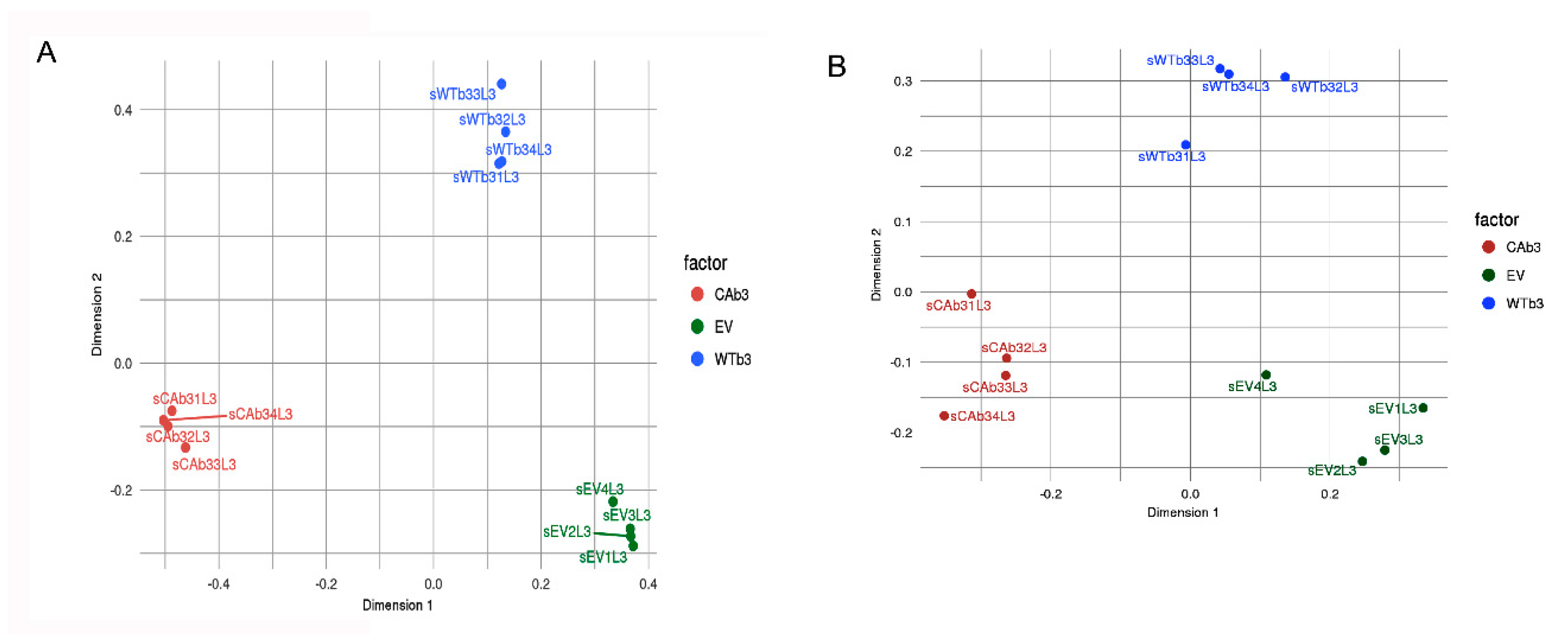
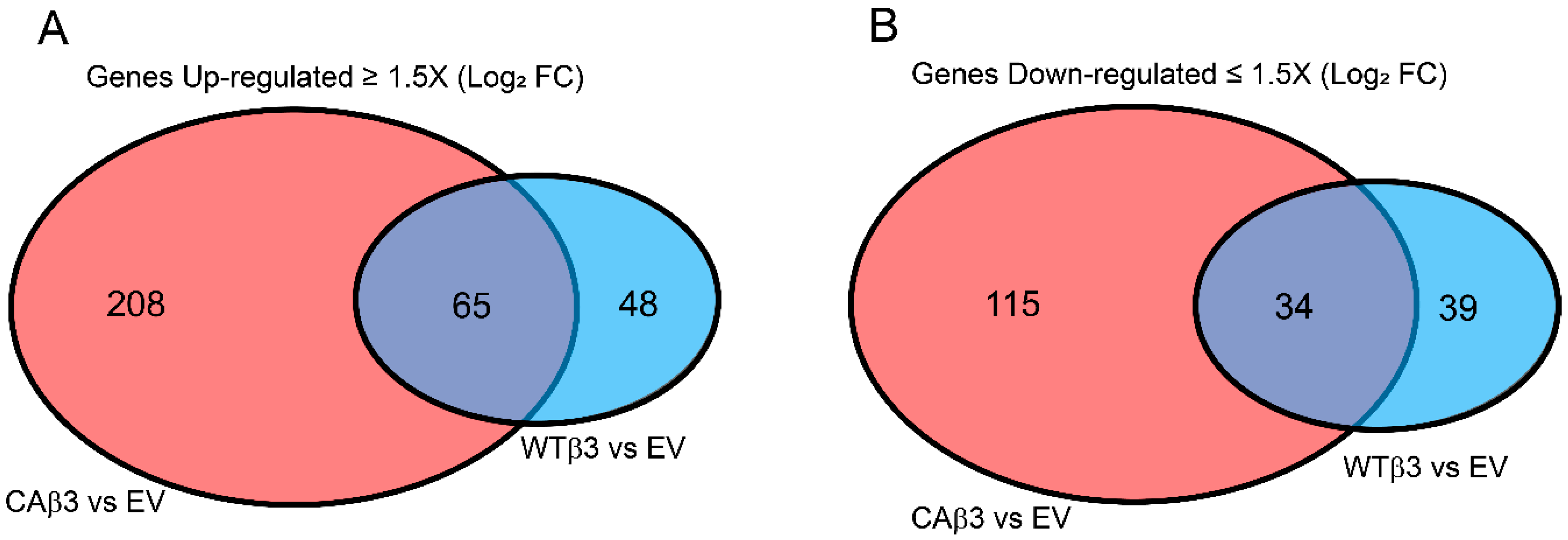



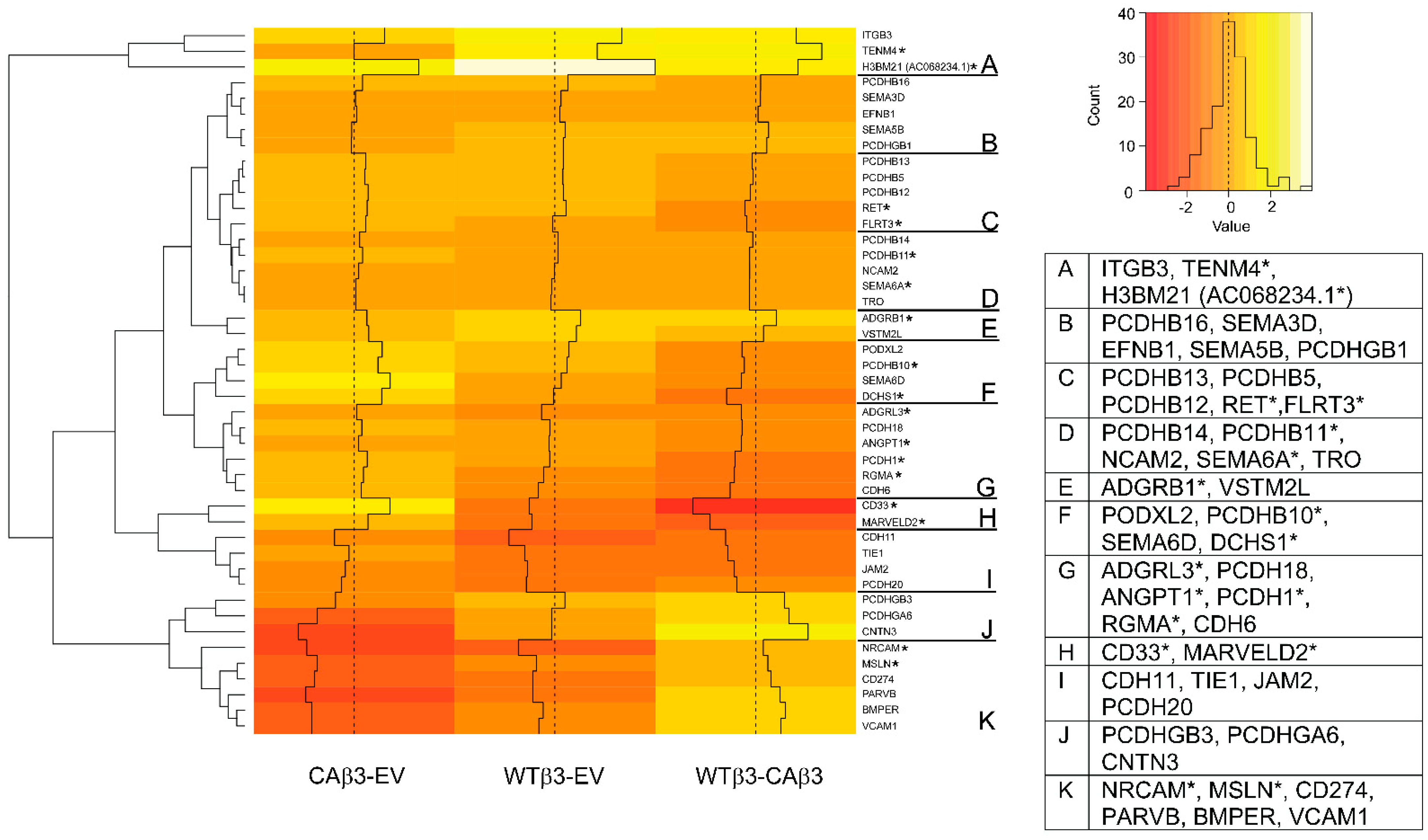

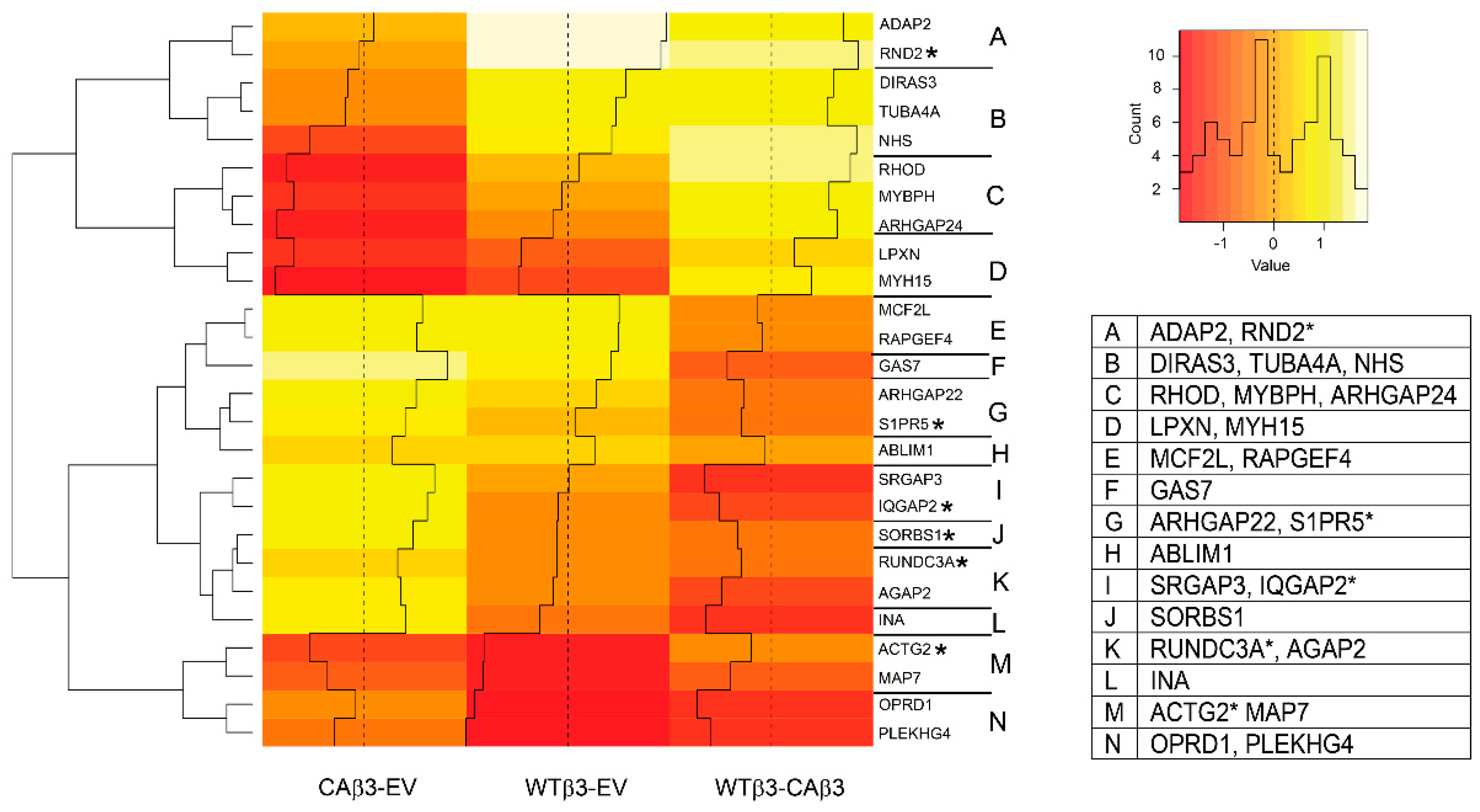
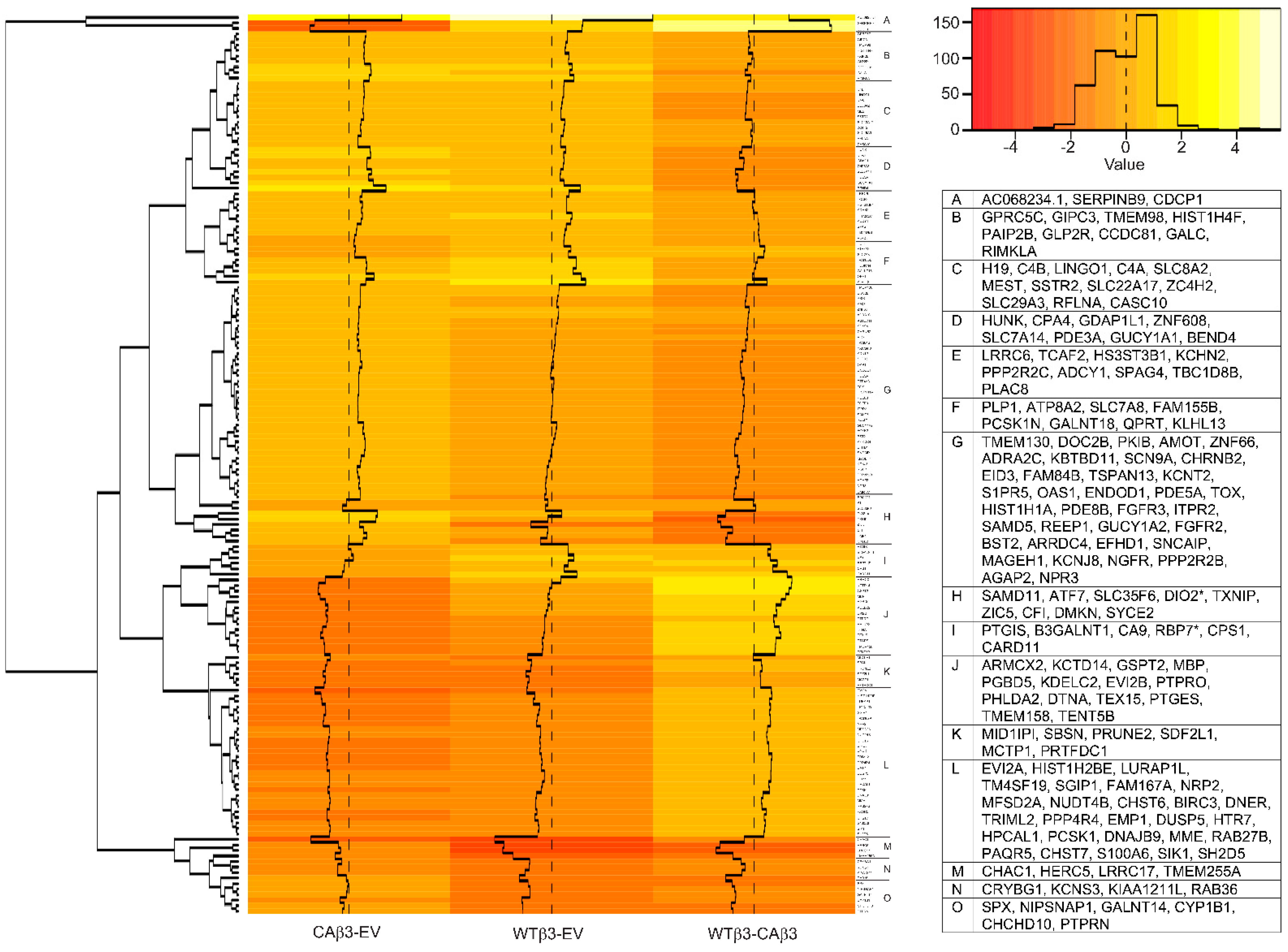
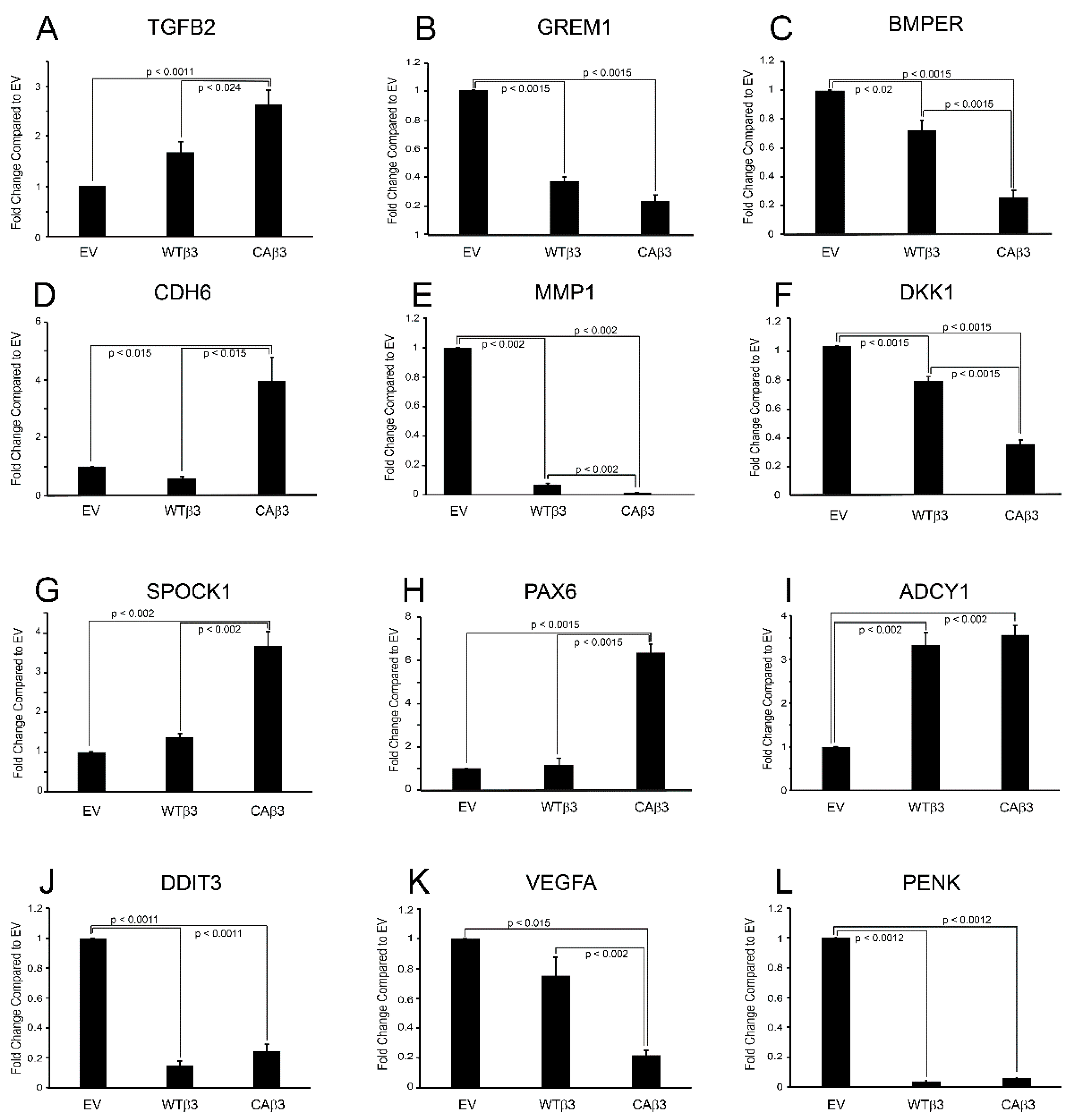
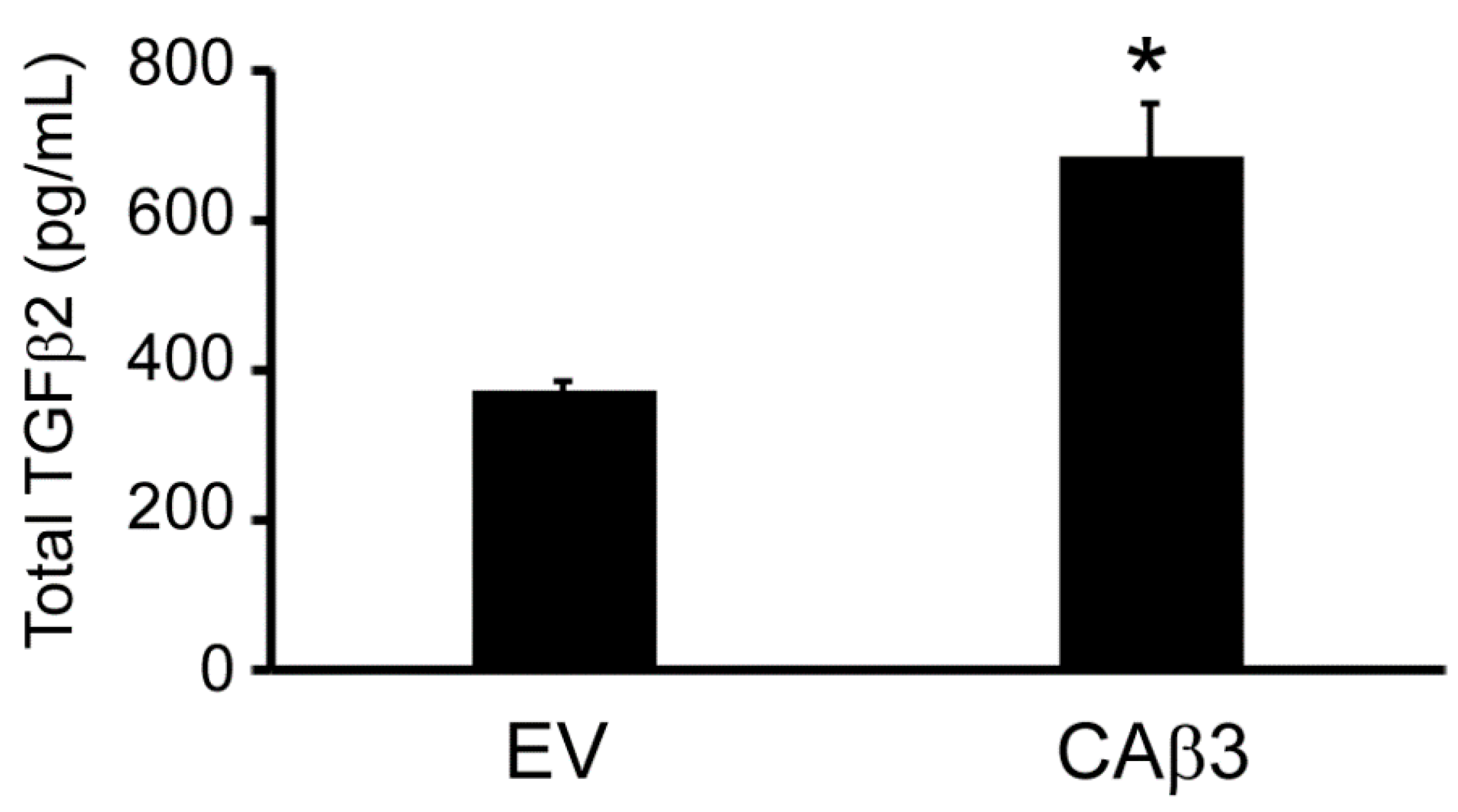
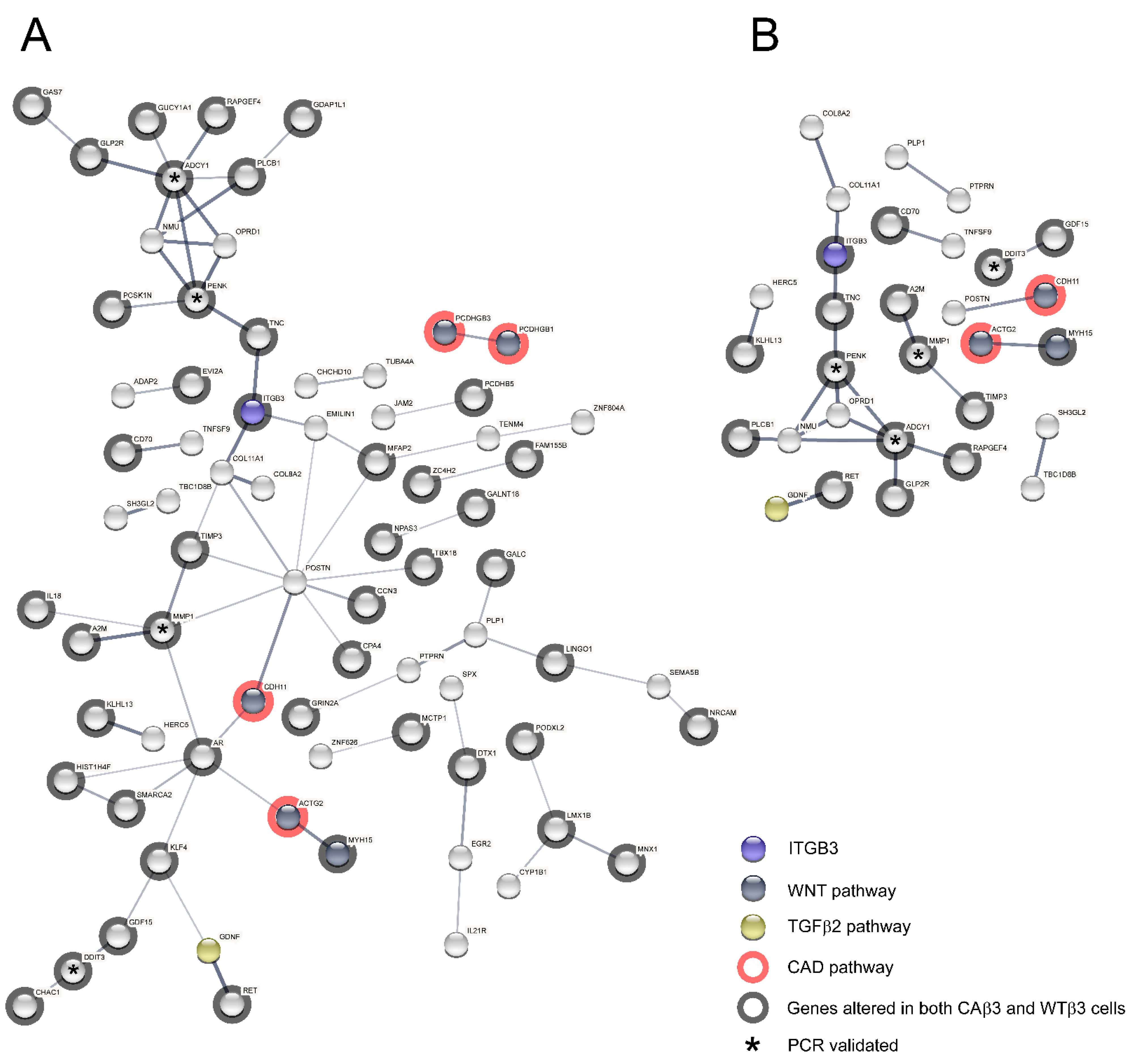
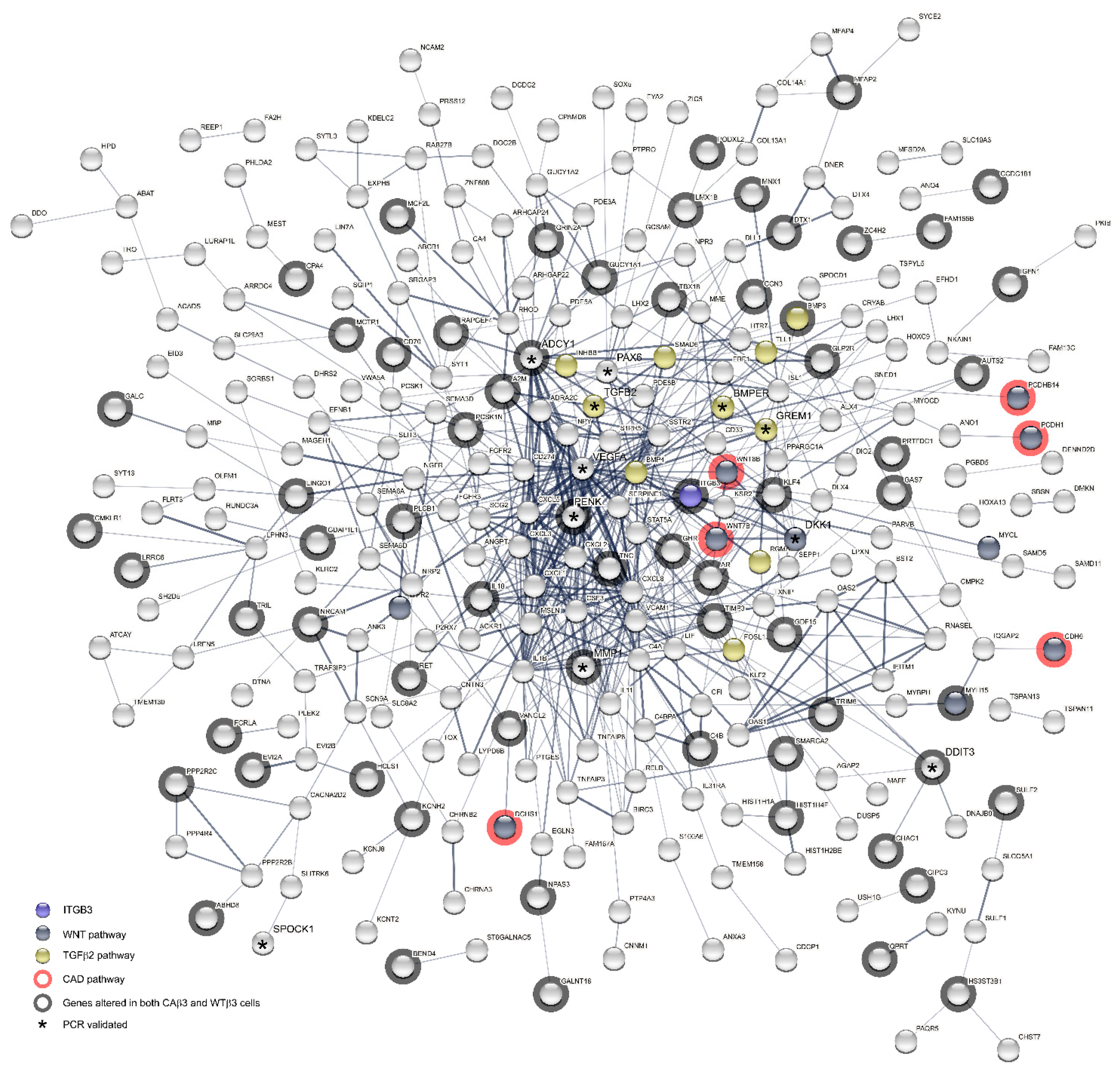
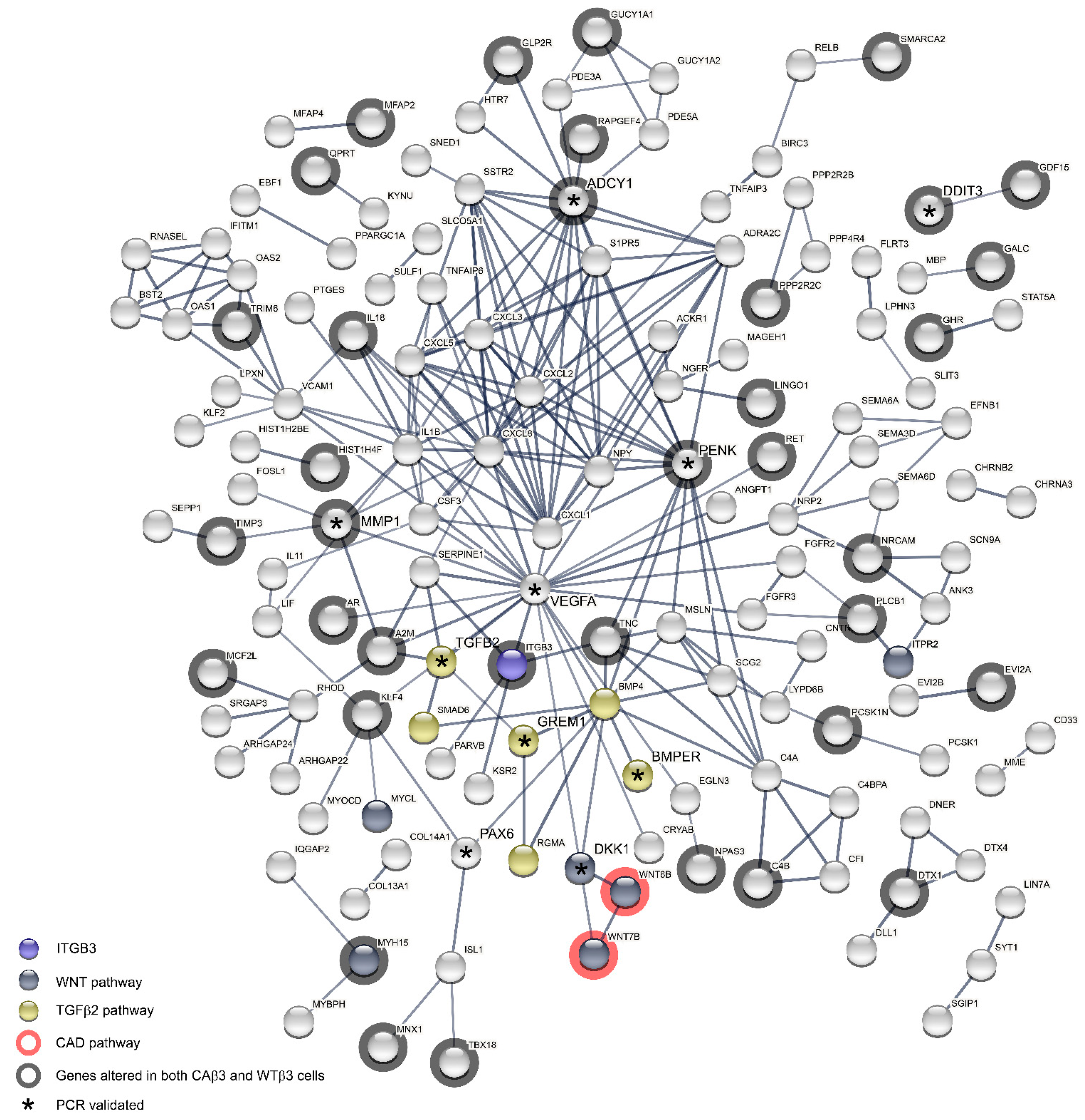
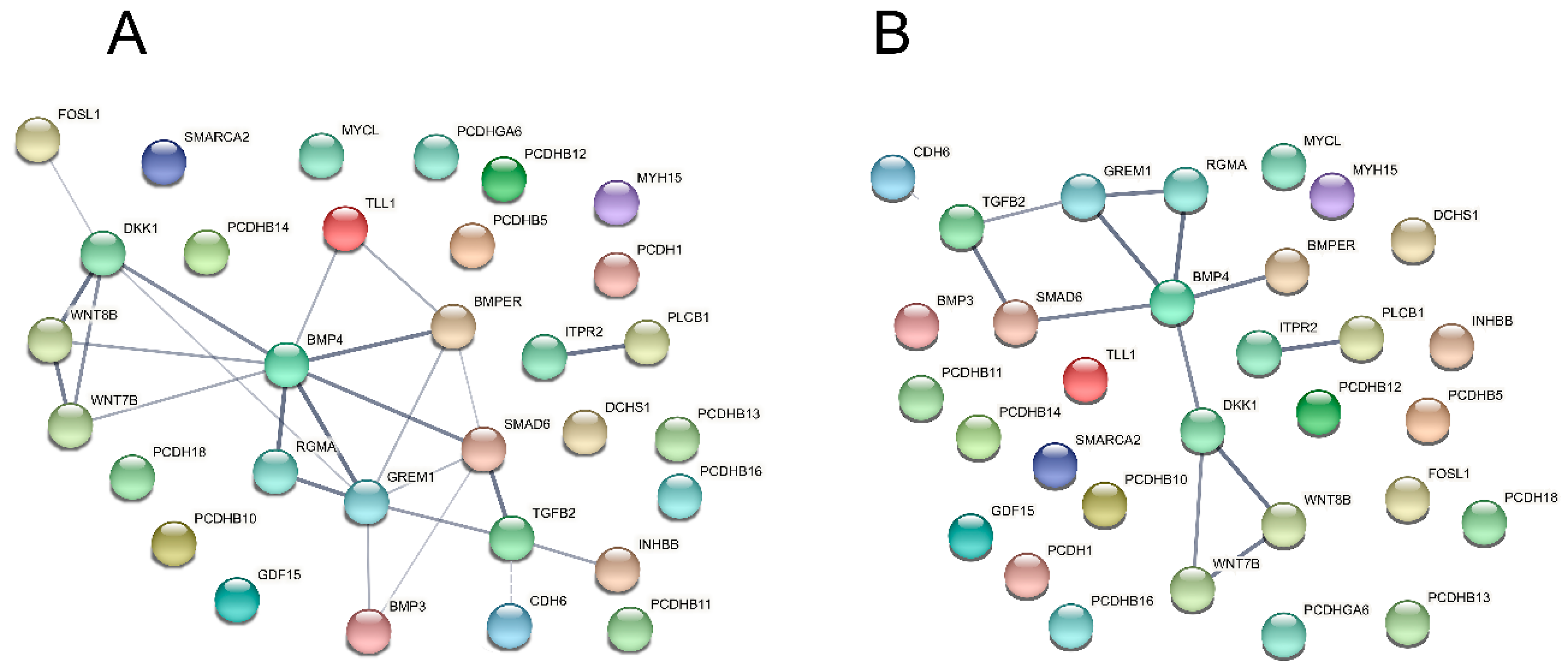
| Contrast | Total # of Genes with Altered Expression Levels (p < 0.05) | # of Upregulated Genes | # of Downregulated Genes |
|---|---|---|---|
| WTβ3-EV | 5186 | 2645 | 2541 |
| CAβ3-EV | 8249 | 4094 | 4255 |
| WTβ3-CAβ3 | 6999 | 3524 | 3475 |
| Glaucoma Association | Gene Symbol | Protein Name | Protein Function | Log2 FC WTβ3 Cells | Log2 FC Caβ3 Cells | References |
|---|---|---|---|---|---|---|
| ASD | ||||||
| PAX6 | Paired Box 6 | Transcription factor | 0.43 * (ND) | 2.97 * (2.78) | [53,54] | |
| CYP1B1 | Cytochrome P450 Family 1 Subfamily B Member 1 | Monooxygenase | −2.28 | −0.37 | [53,55] | |
| POSTN | Periostin | Supports epithelial cell adhesion and migration | 3.88 | 0.53 | [55] | |
| NTG | ||||||
| GAS7 | Growth Arrest Specific 7 | DNA-binding transcription factor activity and actin filament binding | 3.21 | 1.5 | [54,56] | |
| PACG | ||||||
| COL11A1 | Collagen Type XI Alpha 1 Chain | Extracellular Matrix protein | 0.75 | −1.95 | [57] | |
| POAG | ||||||
| TGFB2 | Transforming Growth β2 | Growth factor/Cytokine | 1.62 | 1.23 | [2] | |
| LMX1B | LIM Homeobox Transcription Factor 1 Beta | Transcription factor | 1.65 | 1.52 | [58,59] | |
| SPOCK1 | Testican/Osteonectin | Matricellular protein; induces EMT | 1.92 | 0.70 | [60,61] | |
| MSLN | Mesothelin | Cytokine | −0.73 | −1.60 | [54] | |
| TIMP3 | TIMP Metallopeptidase Inhibitor 3 | Metalloproteinase inhibitor | −1.57 | −2.02 | [60] | |
| MMP1 | Matrix Metallopeptidase 1 | Metalloproteinase | −6.35 | −3.59 | [60] | |
| GALC | Galactosylceramidase | Lysosomal enzyme | 2.00 | 3.09 | [62] | |
| SULF1 | Sulfatase 1 | extracellular heparan sulfate endosulfatase | −0.93 | 1.76 | [54] | |
| COL8A2 | Collagen Type VIII Alpha 2 Chain | Extracellular Matrix protein | 0.41 | 2.71 | [54] | |
| COL11A1 | Collagen Type XI Alpha 1 Chain | Extracellular Matrix protein | 0.75 | −1.95 | [63] | |
| BMP4 | Bone Morphogenetic Protein 4 | Cytokine | 1.69 | 0.30 | [60] | |
| CDH6 | Cadherin 6 | Transmembrane receptor; cell-cell adhesion | −0.59 | 1.97 | [64] | |
| NCAM2 | Neural Cell Adhesion Molecule 2 | Transmembrane receptor; cell-cell adhesion | 0.81 | 1.78 | [65] | |
| ABCB1 | ATP binding cassette subfamily B member 1 | ATP-dependent drug efflux pump for xenobiotic compounds | 0.07 | 3.5 | [66] | |
| TNFAIP3 | TNF alpha Induced Protein 3 | Ubiquitin-editing enzyme | −0.59 | −1.92 | [67] |
| Gene Symbol | Protein Name | Protein Function | Log2 FC WTβ3 Cells | Log2 FC Caβ3 Cells | References |
|---|---|---|---|---|---|
| TGFB2 | TGFβ2 | Growth factor/cytokine | 1.23 | 1.63 | [2] |
| CHD6 | Cadherin 6 | Cell adhesion | −0.59 | 1.97 | [64] |
| CDH11 | Cadherin 11 | Cell adhesion | −3.12 | −0.19 | [68] |
| GREM1 | gremlin | BMP inhibitor | −1.38 | −1.965 | [69] |
| BMPER | bumper | BMP inhibitor | −0.155 | −2.07 | [70] |
| DKK1 | Dickkopf WNT Signaling Pathway Inhibitor 1 | Inhibits beta-catenin-dependent Wnt signaling | −0.44 | −1.91 | [71] |
| DDIT3 | DNA Damage Inducible Transcript 3 | Transcription factor | −2.90 | −2.25 | [72] |
| TM Function | Gene Symbol | Protein Name | Locus | Protein Function | Log2 FC WTβ3 Cells | Log2 FC Caβ3 Cells | References |
|---|---|---|---|---|---|---|---|
| SC Devel. | |||||||
| ANGPT1 | Angiopoietin 1 | GLC1D | Secreted glycoprotein; TEK/TIE2 ligand | 0.365 * (ND) | 2.07 * (1.75) | [80] | |
| PEX | |||||||
| SEMA6A | Semaphorin 6A | GLC1G | Transmembrane receptor; cell-cell adhesion | 0.56 | 1.55 | [80] | |
| UNK | |||||||
| PENK | Proenkephalin | GLC1D | Opioid neuropeptide | −4.95 | −4.22 | [80,81] | |
| DIO2 | Iodothyronine Deiodinase 2 | GLC3G | Oxidoreductase activity | 1.35 * (ND) | 3.98 * (3.77) | [80] | |
| RBP7 | Retinol Binding Protein 7 | GLC3B | Retinol-binding protein | 1.96 * (1.925) | 0.11 * (ND) | [80] |
| Type | Sequence |
|---|---|
| TGFB2 | f- CAGCACACTCGATATGGACCA r- CCTCGGGCTCAGGATAGTCT |
| DDIT3 | f- TTGCCTTTCTCCTTCGGGAC r- CAGTCAGCCAAGCCAGAGAA |
| CDH6 | f- AGAACTTACCGCTACTTCTTGC r- TGCCCACATACTGATAATCGGA |
| BMPER | f- GTGCTTGTGTGAAAGGCAGG r- AAACGTACTGACACGTCCCC |
| GREM1 | f- ACTCTCGGTCCCGCTGA r- CAAGAGGAGAAGCAGGGCTC |
| MMP1 | f- GGTGTGGTGTCTCACAGCTT r- CGCTTTTCAACTTGCCTCCC |
| SPOCK1 | f- GACCTCCTGCTTGACCCTTC r- TTTGTCCACACACCAGCACT |
| PAX6 | f- TCAAGCAACAACAGCAGCAC r- TCACTCCGCTGTGACTGTTC |
| ADCY1 | f- GTCGGATGGATAGCACAGGG r- TTTGGGAGCCGTTTCCATCA |
| PENK | f- ATCCTCGCCAAGCGGTATG r- GGTTGTCCCCTGTTTCCAGA |
| VEGFA | f- CTGCTGTCTTGGCTGCATTGG r- CACCGCCTCGGCTTGTCACAT |
| DKK1 | f- GTGCAAATCTGTCTCGCCTG r- GCACAGTCTGATGACCGGAG |
| SDHA | f- TGGGAACAAGAGGGCATCTG r- CCACCACTGCATCCAATTCATG |
| Pathway | # of Reference Genes | # of Genes | Expected # of Genes | Fold Enrichment | Raw p-Value | False Discovery Rate |
|---|---|---|---|---|---|---|
| TGFβ2 signaling | 102 | 8 | 1.81 | 4.43 | 0.000686 | 0.0286 |
| Wnt signaling | 317 | 19 | 5.62 | 3.38 | 0.0000077 | 0.000429 |
| Cadherin signaling | 164 | 14 | 2.91 | 4.82 | 0.00000304 | 0.000254 |
| Functional Classification | Gene Name | Protein Name | CAβ3-EV Log2 FC | Effect on TGFβ, BMP or Wnt Signaling |
|---|---|---|---|---|
| Transcription | ||||
| DDIT3 | DNA damage inducible transcript 3 | −0.2.25 | Targets TGFβ; Wnt [97] | |
| ISL1 | ISL LIM Homeobox 1 | 8.81 | Targets BMP [98] | |
| KLF2 | Kruppel like factor 2 | −1.54 | Targets TGFβ [99]; Wnt [100] | |
| KLF4 | Kruppel like factor 4 | −2.59 | Targets TGFβ [47]; BMP [99]; Wnt [101] | |
| MYOCD | Myocardin | −2.94 | Targets TGFβ [102]; Wnt [103] | |
| PAX6 | Paired box 6 | 2.78 | Targets TGFβ [104] | |
| SOX5 | SRY-box 5 | 3.49 | Targets Wnt [105] | |
| STAT5A | Signal transducer and activator of transcription 5A | 3.32 | Targets Wnt [106] | |
| Adhesion | ||||
| BMPER | BMP binding endothelial regulator | −2.07 | Targets BMP [107] | |
| PCDH1 | Protocadherin 1 | 2.48 | Targets TGFβ [108] | |
| ECM | ||||
| SULF1 | Sulfatase 1 | 1.76 | Targets TGFβ [109] | |
| TLL1 | Tolloid like 1 | 4.19 | Targets TGFβ [110] | |
| TNC | Tenascin C | −3.59 | Targets TGFβ [111] | |
| Cytokines | ||||
| BMP4 | Bone morphogenetic protein 4 | 1.69 | Targets TGFβ [69] | |
| GREM1 | Gremlin 1 | −1.97 | Targets BMP [69] | |
| IL18 | Interleukin 18 | −3.75 | Targets TGFβ [112] | |
| Cytoskeleton | ||||
| AGAP2 | ArfGAP with GTPase domain, ankyrin repeat and PH domain 2 | 1.77 | Targets TGFβ [92] | |
| LPXN | Leupaxin | −1.51 | Targets Wnt [113] |
Publisher’s Note: MDPI stays neutral with regard to jurisdictional claims in published maps and institutional affiliations. |
© 2021 by the authors. Licensee MDPI, Basel, Switzerland. This article is an open access article distributed under the terms and conditions of the Creative Commons Attribution (CC BY) license (https://creativecommons.org/licenses/by/4.0/).
Share and Cite
Filla, M.S.; Meyer, K.K.; Faralli, J.A.; Peters, D.M. Overexpression and Activation of αvβ3 Integrin Differentially Affects TGFβ2 Signaling in Human Trabecular Meshwork Cells. Cells 2021, 10, 1923. https://doi.org/10.3390/cells10081923
Filla MS, Meyer KK, Faralli JA, Peters DM. Overexpression and Activation of αvβ3 Integrin Differentially Affects TGFβ2 Signaling in Human Trabecular Meshwork Cells. Cells. 2021; 10(8):1923. https://doi.org/10.3390/cells10081923
Chicago/Turabian StyleFilla, Mark S., Kristy K. Meyer, Jennifer A. Faralli, and Donna M. Peters. 2021. "Overexpression and Activation of αvβ3 Integrin Differentially Affects TGFβ2 Signaling in Human Trabecular Meshwork Cells" Cells 10, no. 8: 1923. https://doi.org/10.3390/cells10081923
APA StyleFilla, M. S., Meyer, K. K., Faralli, J. A., & Peters, D. M. (2021). Overexpression and Activation of αvβ3 Integrin Differentially Affects TGFβ2 Signaling in Human Trabecular Meshwork Cells. Cells, 10(8), 1923. https://doi.org/10.3390/cells10081923





